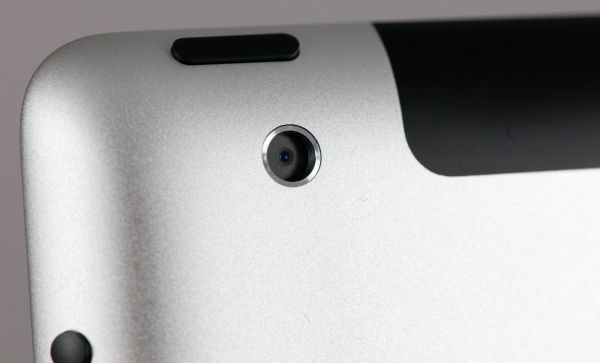Apple iPad 2 Preview
by Anand Lal Shimpi, Brian Klug & Vivek Gowri on March 12, 2011 6:01 AM ESTCamera
Probably the only major disappointment about the iPad 2 is the cameras, oh the cameras. They're identical to the two cameras in the latest generation iPod touch, and are overall something of a disappointment.
The rear facing camera is a native 1280x720 when shooting video, which crops down to 960x720 (4:3) when taking stills. All the camera app does is toss away 160 pixels on the left and right side when taking still images. There's no autofocus at all, it's just fixed focus, meaning taps on the display simply change exposure. Change to video and you'll see magnification preserved entirely. It's obvious this back sensor was chosen with the intention of shooting video given its apparent native 1280x720 resolution.

Left: Still mode, Right: Video capture mode
The iPad 2 camera reminds me of the iPhone 3G camera. It's less impressive than the iPhone 3GS camera which had autofocus and relatively decent image quality, and positively destroyed compared to the iPhone 4 camera system.
 iPad 2 front facing camera - Above it is the ambient light sensor
iPad 2 front facing camera - Above it is the ambient light sensor
The front camera is actually similar to what we've seen before out of all the iDevice front facing cameras - it's VGA with equally ok performance. White balance seems off inside the light box we use for smartphone testing, as the test images have a distracting reddish cast.
Stills on the rear camera aren't impressive at all, and what makes it worse is that the images are noticeably blurry and noisy when upscaled to the iPad's native XGA resolution. I was shocked to see that the camera preview scales both the front and back camera images all the way up. It looks downright hilarious in person and shows off everything bad about those two cameras.
Video quality is almost exactly the same as the iPod Touch (latest gen with cameras). It's actually pretty good, though I want to do more testing before passing judgement. It's still 720P H.264 Baseline L3.1 at 29.97 FPS. Our demo video is 10.8 Mbps.
The microphone location for the iPad 2 is (at least on the 3G version) right in the middle of the plastic RF window. It's a super small little port with mesh grating. I found out the hard way that it's also right where you want to hold the iPad naturally, and covered it with my hand in the video above. Apologies about the noise.
 iPad 2 microphone in the middle of RF window
iPad 2 microphone in the middle of RF window
What I like about Apple is that usually their UI is some of the most carefully thought out around. Nine times out of ten, it's almost shockingly intuitive, and clearly carefully thought-out. Look no further than how the original iPad's mail app layout has become the most emulated landscape UI design ever.
That said, it's that one time out of ten when things go awfully, terribly, shockingly wrong - sadly, that's precisely what happened in the camera app. The problem is that the camera control bar moves when the iPad is rotated. Yes, it moves. Contrast that to the iPhone and iPod Touch where the bar never moves, and the capture button is always on the bottom near the home button - icons rotate, but the whole bar doesn't move. On the iPad 2, icons rotate, and the whole bar moves.

Left: Portrait, Right: Landscape - Note how the capture button is always at the bottom
In both landscape and portrait view, the capture button goes to the bottom of the screen, dead center. In portrait, it's not too hard to just stretch the thumb and tap capture. It isn't comfortable, but it's doable. In landscape however, you either need to either hold the iPad 2 with one hand and tap the capture button with a free hand (which is a great way to accidentally drop the thing or introduce biblical amounts of camera shake), or stretch your thumb to the max and hope to goodness it's long enough to reach the button. In both portrait and landscape, putting the capture button at the bottom is undeniably awkward. This could've been the perfect opportunity to introduce a transparent capture button mid-screen on the sides where the thumbs could naturally tap. Instead, we're left with the most awkward position possible.
To Be Continued...
We couldn't help but share some of our initial thoughts/impressions with you guys but there's still much more to do. Battery life is next on the to-do list along with our continued hunt for a greater understanding of Apple's iPad 2. Check back next week for our full review!




















82 Comments
View All Comments
erple2 - Tuesday, March 15, 2011 - link
In the iOS case - they're synonymous. You can't get the "new" browser without also getting the new OS update.tipoo - Saturday, March 12, 2011 - link
In addition to software differences, each company also tweaks the design of the Cortex A9 to their liking. After ARM licences it out they can do pretty much whatever to it. So you might see Qualcomm adding cache, Nvidia doubling the bus, or whatever.metafor - Tuesday, March 15, 2011 - link
ARM core licenses do not allow you to modify the CPU design. ARM allows different options when configuring cache size and bus width and co-processors but only with their macro-generator. There's definitely flexibility, but it's not "whatever you want". There are limited flavors if you will of yummy goodness.Anand Lal Shimpi - Saturday, March 12, 2011 - link
While the underlying architecture between those devices may be similar, there are some differences. For example NVIDIA's Tegra 2 only has a single channel 32-bit LPDDR2 memory interface while TI's OMAP 4 has a dual-channel LPDDR2 memory interface.Tegra 2 also lacks an MPE (SIMD engine) while the OMAP 4 doesn't.
Take care,
Anand
tipoo - Saturday, March 12, 2011 - link
I'd be interested in a comparison between all these mobile processors. I understand its difficult since the iPad uses a different OS, but given the numbers where do you think it stands compared to Tegra 2 and the like?zhill - Saturday, March 12, 2011 - link
My understanding is that the ARM Cortex A9 is just an instruction set and architecture specification/chip design. Each company manufactures the actual chips themselves so they can make additional changes at the hardware level such as lithography, voltage, clock frequency, cache sizes etc. So they license the design from ARM, but build the silicon themselves so each design may vary in terms of actual implementation and performance.Software also certainly makes a difference.
winterspan - Saturday, March 12, 2011 - link
you are right to an extent. There are actually two different licenses, a manufacturing license and a "design" license. Basically, if you pay more for the design license, they can make a custom core that implements the ARM Cortex v7 instruction set. This is what Qualcomm does with their Snapdragon. Most of the other guys just have the manufacturing license and this enables mild adjustments, but essentially they all have to use a similar Cortex-A9 core.Not sure what the Apple cores are... Standard Cortex-A9 or something more custom from Intrinsity/Samsung?
jmmx - Sunday, March 13, 2011 - link
"If Apple iPAD 2, NVIDIA's Tegra 2, TI's OMAP 4 and Samsung's Exynos all use the same Dual Core ARM Cortex A9…"There is more to it than this. The simple fact is they do NOT "use the same Cortex A9." They each user their own implementation of the A9. Additionally, A9 is the core cpu design, but the chips are SoC chips "System on a Chip" That is, they contain a lot more than just the A9 CPU but other non CPU functional units as well.The configuration of these units can significantly affect performance.
This is my understanding of the situation. (Caveat - I am a software engineer not hardware.) Someone out there feel free to correct me if I am mistaken about this.
str1ke007 - Saturday, March 12, 2011 - link
Can the ipad2 be tetherd to an iphone ?? (so i can use the 3G data i allready pay for rather then paying for another sim/plan)kmmatney - Saturday, March 12, 2011 - link
There is no reason why you couldn't, and this is what I plan on doing. However I would like to know if the map and GPS apps work well on an iPad without 3G. Do you need to get a 3G for the GPS to work properly?